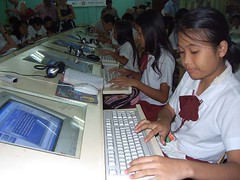
Clive Shepherd recently wrote a good
post on his blog
'Clive on Learning', pointing out some of the main benefits of collaborative learning, such as improved student motivation, team work and breaking down of the traditional teacher-learner relationship into a more peer-to-peer model.
In the UNESCO SchoolNet project, one of the most succesful aspects was telecollaboration. Many of the teachers from the telecollaboration (using the
Learning Circles model) were extremely enthusiastic about the process. Basically, schools from eight countries worked together on shared curricular topics in the areas of maths, science and English, and sent questions and answers via email to each other, followed by presentations and other digital work done by the students.
The teachers mentioned that there were many benefits for students:
- increased motivation for learning the curricular topic
- improved tolerance to other people's views and means of expression
- better international understanding
- peer-to-peer learning took place; both student to student and student to teacher
- they made friends in other countries.





